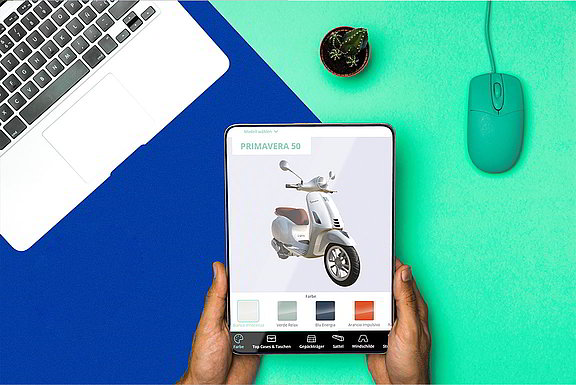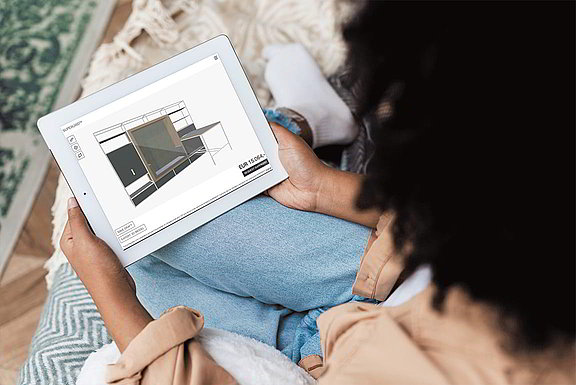What does configure mean?
Author: Elisabeth Sonnleitner
Computers, cars, furniture, clothing: configuration is the trend. 71 percent of customers want a personalized shopping experience and products that meet their exact requirements - otherwise frustration is inevitable, according to a McKinsey study. We explain what's behind product configuration, how it works technically, and how configurators are transforming digital sales in all industries.
What does "configure" mean?
The word "configure" goes back to the Latin word configurare, which translates as "to shape in the same way". Today, the term is primarily used to describe the design or adaptation of an object to our needs.
What can be configured?
A product can be configurable in two different ways:
- To adjust the settings of a product: Most often today, the term 'configure' is used in the context of customizing a piece of software. Configuring an application means adapting the settings to the needs of the users the prerequisites of the system.
- Customize products before purchase: Product configuration usually refers to the customization of a product before it is actually purchased and usually before it is actually produced. Product configurators are used particularly frequently for complex, high-priced products that require explanation - for example, furniture, vehicles, garden sheds, or computers.

How do product configurators work?
Modern product configurators are accessed by the customer via a website or app and display the product as a 3D model that can be configured within the virtual environment. The user customizes the product based on predefined parameters such as color, material or features, and can view the product from all sides. The technical prerequisites for this have existed for a long time, but it is only with the spread of modern hardware and software that product configurators are unleashing their radiance on sales in all industries:
- Smartphone distribution: 96 percent of Germans use a smartphone - and thus always have their access to the digital world in their pocket. They not only have access to websites, but also to apps, which companies in turn use to establish a direct line to customers.
- Augmented reality: The camera integrated in almost every smartphone acts as an interface to the real world to present the later product directly in the real environment.
- Interfaces: Thanks to modern APIs, connecting ERP, PIM, CRM and other business systems to the product configurator has never been easier, so that the new sales tool fits seamlessly into the existing process landscape and up-to-date data is always available in all systems.
Mega trend personalization: Why product configurators are becoming more important across industries
Configuration is not an invention of the digital world. In industries such as kitchen manufacturing, companies have been working with configurations according to customer requirements for a very long time, but the configuration often takes place in direct dialog with the sales representative. By digitizing and automating this process with product configurators, the technology is becoming interesting for all industries and business models:
-
Product configuration in retail: From individually printed T-shirts to digitally configured custom-made wall units: In B2C sales, product configurators have created the biggest buzz in the last 10 years. More and more retailers are coming under pressure due to the dominance of digital platforms and need to offer their target groups a unique selling proposition that goes beyond the price point of the product. At the same time, in an era of ubiquitous availability of almost every product, customers want new ways to express their individuality and stand out from the crowd.
-
Product configuration in B2B sales: According to a GEXSO survey, 4 out of 5 industrial companies consider the use of product configurators to be crucial for their long-term success. Modern plants and machines are often complex and are manufactured according to the customer's wishes anyway. Product configurators bring the principle into the digital world and enable efficient sales with less support effort.
- Product configurators in D2C sales: Product configurators make it easier for product manufacturers to establish a direct sales channel to end customers and increase their own margins. With the help of a configurator, even complex products such as cars, garden sheds or furniture can be marketed directly to end customers in digital form. Producers have the opportunity to become less dependent on retail sales and build a long-term customer relationship by securing a strong position in the market with an authentic story and a personalized shopping experience.

Conclusion: Configuring means personalizing
Personalized products and individuality in the purchasing process are no longer optional. Modern customers want customizable products that meet their needs exactly and are increasingly unwilling to make compromises. At the same time, according to a survey by Gartner, 2 out of 3 companies have problems with implementation. At Combeenation, we guide you on the path to higher sales and conversion rates with a 3D product configurator. Reach your customers without detours via digital platforms or retail and give them what they want: Customizable products and tailored shopping experiences! Start your journey to more success in digital sales today and make a non-binding consultation appointment!
This might also interest you: